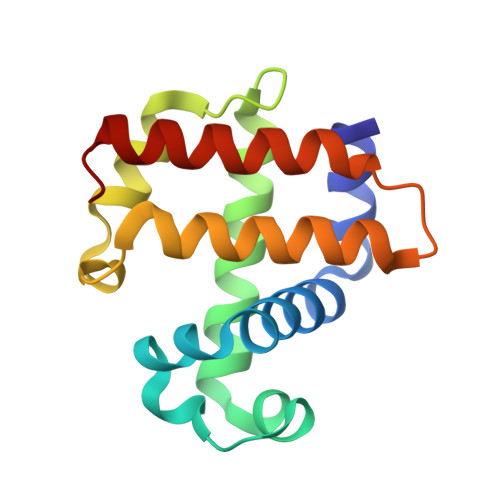Bridging the functional gap between reactivity and inhibition in dehaloperoxidase B from Amphitrite ornata: Mechanistic and structural studies with 2,4- and 2,6-dihalophenols.
Malewschik, T., Carey, L.M., de Serrano, V., Ghiladi, R.A.(2022) J Inorg Biochem 236: 111944-111944
- PubMed: 35969974
- DOI: https://doi.org/10.1016/j.jinorgbio.2022.111944
- Primary Citation of Related Structures:
7M1I, 7M1J, 7M1K - PubMed Abstract:
The multifunctional catalytic globin dehaloperoxidase (DHP) from the marine worm Amphitrite ornata was shown to catalyze the H 2 O 2 -dependent oxidation of 2,4- and 2,6-dihalophenols (DXP; X?=?F, Cl, Br). Product identification by LC-MS revealed multiple monomeric products with varying degrees of oxidation and/or dehalogenation, as well as oligomers with n up to 6. Mechanistic and 18 O-labeling studies demonstrated sequential dihalophenol oxidation via peroxidase and peroxygenase activities. Binding studies established that 2,4-DXP (X?=?Cl, Br) have the highest affinities of any known DHP substrate. X-ray crystallography identified different binding positions for 2,4- and 2,6-DXP substrates in the hydrophobic distal pocket of DHP. Correlation between the number of halogens and the substrate binding orientation revealed a halogen-dependent binding motif for mono- (4-halophenol), di- (2,4- and 2,6-dihalophenol) and trihalophenols (2,4,6-trihalopenol). Taken together, the findings here on dihalophenol reactivity with DHP advance our understanding of how these compounds bridge the inhibitory and oxidative functions of their mono- and trihalophenol counterparts, respectively, and provide further insight into the protein structure-function paradigm relevant to multifunctional catalytic globins in comparison to their monofunctional analogs.
Organizational Affiliation:
Department of Chemistry, North Carolina State University, Raleigh, NC 27695-8204, United States.




















